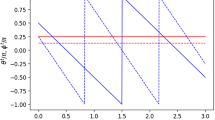Abstract
A new Monte Carlo method is described for quantum (s= 1/2) spins which maps the spin model onto a model of hard-core bosons. The Hamiltonian is then broken up into kinetic and potential parts and the Trotter formula used to simulate the Bose system. The power of this mapping comes from the fact that, by letting the system evolve through unphysical spin states between imaginary time slices, the needed matrix elements have simple expressions.
Specifically, for quantum Hamiltonians
withH 1 diagonal in thez components of the spins, we map the spins onto boson operators usingS +=Ssux+iSy→ψ †,S −=Sx−iSy→ψ, andS z→n−1/2, withn=ψ †ψ Unfortunately, the mapping is not quite exact since one may create an unlimited number of bosons on any site while there are only two spin states per site. A large number of analytic calculations have been performed successfully by suppressing the unphysical statesn > 1 either energetically, as in ferromagnetic spin-wave calculations, or formally, as in Holstein-Primakoff or Dyson-Maleev transformations. In numerical simulations, however, one may do something much more simple; a termHC may be introduced into the Hamiltonian which projects out unphysical states. Formally,HC is zero for allowed states but infinite otherwise; alternatively,P HC =exp(−ɛ · HC) projects out states for anyɛ > 0, giving unity for physical states but zero for unphysical ones. In practice, the analytic form ofHC is of no concern since it may be “hard-wired” into the algorithm to allow only hard-core states. The
Hamiltonian becomes
where the\(t_{i,j} = \tfrac{1}{2}J_{i,j} \) are the hopping coefficients for the bosons.
The Trotter formula may now be used to approximate matrix elements:e -β·H=(e -Δτ·H)L, whereβ=L·Δτ ande -Δτ·H ≈e -Δτ·T e -Δτ·HI e -Δτ·HC. Since we will use an occupation-number representation,H I , will be diagonal and easily exponentiated. The hard-core projection operatorP HC , again, will act only through the Monte Carlo moves which prohibit unphysical states. Only the exponential of the kinetic term remains to be evaluated. The factor exp(−Δτ · T) evolves the bosons between time slices as indistinguishable, free particles-without concern for physical/unphysical states nor for interactions among the particles—and so is easily expressed as a sum of products of single-particle propagators, as developed in any elementary quantum-mechanics text. The final picture, then, is one in which the indistinguishable particles evolve through imaginary time as though they are free, with interactions and the physical-state projector operating only everyΔτ. Sampling over permutations of world lines and performing the calculation on a lattice produces a relatively fast algorithm. The simulation generates configurations which are described byL lattice configurations on the various imaginary-time slices as well as the permutations that assign world lines from bosoms on one time slice to those on the next. Monte Carlo moves must both wiggle world lines around as well as reassign them.
Any operator which is diagonal in the occupation-number representation may be measured in this simulation, even if it is a product of operators at different times. In addition, any operator, or product of such operators at different time slices, that conserves the boson number at each time slice can be measured. The resulting set of observables includes the energy, specific heat, and the parallel and transverse magnetizations and susceptibilities.
To test the breakup, particularly the validiy of separating outHC with its infinite matrix elements, exact numerical calculations were carried out for small systems. It was found that in measuring the average value of an operatorA which has some nonzero matrix elements between physical and unphysical states, a dramatic improvement in convergence results if one projects out these elements-that is, the dependence of the estimator 〈P HC ·A·PHC〉 on the breakup parameterΔτ is much smaller than that for 〈A〉. To test the breakup further, we have studied spin-1/2 rings using Monte Carlo simulation, measuring both the energy and structure factor on 30-site rings for the XY model.
The algorithm was also used to perform a Monte Carlo simulation of the quantum XY model in two dimensions on up to 15×16-site lattices. The specific-heat peak height saturates quickly with lattice size and is consistent with the value ofC max=0.65 from previous extrapolations of exact results on small lattices. As a rough comparison of running times, this algorithm produced data of similar quality as a checkerboard decomposition in one-tenth of the time.
Similar content being viewed by others
Author information
Authors and Affiliations
Rights and permissions
About this article
Cite this article
Loh, E. A Monte Carlo method for quantum spins using boson world lines. J Stat Phys 43, 875–876 (1986). https://doi.org/10.1007/BF02628315
Issue Date:
DOI: https://doi.org/10.1007/BF02628315




